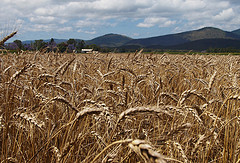
Farmer’s lung is a serious respiratory condition also known as hypersensitivity pneumonitis. It affects people whose immune system is sensitive to fungal spores inhaled from:
- Mouldy hay
- Straw
- Grain
- Compost
Farmer’s lung is different from farmer’s fever also known as (ODTS – Organic Dust Toxic Syndrome) because it involves an allergic immune response that leads to inflammation and permanent tissue damage in the terminal airways of the lung. Farmers lung is associated with intense or repeated exposures to biologic dust and different organisms can cause farmers lung. It was described as early as 1713 notably in farmers exposed to organic dusts. Spread between people is non-existent, however, common exposure to the offending agent can lead to similar and numerous cases. Some agricultural industries with possible known exposures associated with hypersensitivity pneumonitis include:
- Greenhouse farming
- Mushroom, farming
- Bird or poultry handling (‘bird breeder/fancier’s lung’)
- Grain processing (wheat weevil disease)
- Hay packing, storing and handling particularly when humid
- Woodworkers lung
Symptoms
The symptoms of farmer’s lung in acute attacks can last from 12 hours to 10 days. Symptoms include:
- Chills
- Fever
- Cough
- Shortness of breath
- Tight feeling in the chest
- Tiredness
For those farmers who are sensitive, repeated exposure to the allergic trigger can lead to more severe symptoms such as chronic cough with phlegm containing pus, shortness of breath, loss of appetite and weight loss. Lung scarring (fibrosis) can occur in the later stages of the disease which greatly impacts respiratory health and cause difficulty breathing.
Farmer’s lung can be prevented by ensuring organic materials are kept dry and stored properly. Also keeping away from known allergens. Keep storage areas well-ventilated and wear appropriate Australian Standard respiratory masks which seal the face properly and protect the lungs. If working in greenhouse environs ensuring adequate ventilation and appropriate breaks out of the environment. These actions will minimise the risk of inhaling the allergic trigger and prevent the condition developing or progressing.
Fast facts:
- Farmer’s lung is often caused by inhaling fungal spores or bacteria from mouldy hay, grains, compost.
- Farmer’s lung can be slowed if it is identified early. So tell your doctor about any symptoms like breathing problems, chills and fevers.
- Keep hay, grains and other organic materials dry as fungal spores can only grow in moist conditions.
- Wear Personal Protective Equipment (PPE) if having to work at high risk sites.
- As farmers lungs symptoms are like a viral illness if can be misdiagnosed.
References used for this topic
More information:
RACGP – Australian Family Physician 2012
The respiratory tract
The National Center for Biotechnology Information
Pulmonary Health Effects of Agriculture (2016)
StatPearls [Internet]. Treasure Island
Farmers Lung
Canadian Centre for Occupational Health and Safety
Farmers lung
JAMA Network
An Outbreak of Organic Dust Toxic Syndrome in a College Fraternity
Cedars-Sinai (US)
Hypersensitivity pneumonitis
University of California
Hypersensitivity pneumonitis – signs and symptoms
Zergham AS, Heller D. Farmers Lung. [Updated 2020 May 22]. In: StatPearls [Internet]. Treasure Island (FL): StatPearls Publishing; 2021 Jan-. Available from: https://www.ncbi.nlm.nih.gov/books/NBK557580/
Research & reviews:
National Center for Biotechnology Information
Systematic review of respiratory health among dairy workers.
European Respiratory Journal
Hypersensitivity pneumonitis – current concepts [PDF 132kb]
|
|